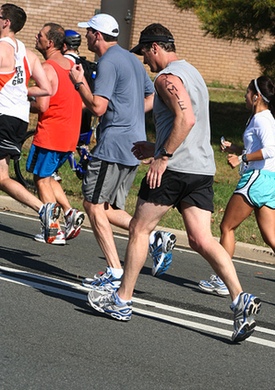
Hills. Just saying the word makes almost every runner flinch in fear.
Unfortunately, they aren’t something you can always avoid–if you’ve run the final leg of the Marine Corps Marathon you can attest to that.
Luckily, two-time World Champion triathlete Ken Mierke has some great tips for conquering those mighty hills, including how to improve your technique and a workout to include in your weekly regimen. “Efficient technique is an enormous part of effective hill running,” Mierke says. “No runner is strong enough to waste energy on hills with inefficient technique.” Read on for his tips.
Running Uphill
• Drive knees and arms powerfully toward the top of the hill. Your arms should be doing a lot of the work.
• Minimize foot contact time with the ground. Your gait should feel almost like you’re bouncing.
• Maintain the same high turnover used when running on flat surfaces.
Running Downhill
• Lean forward, keeping your body in a straight line from the foot.
• Keep hips parallel with the road instead of stair-stepping.
• Put foot down early on leg recovery, striking behind the hips.
Next, work on building your endurance with this hill interval workout created by Mierke. Interval training should be conducted at a TT6 pace, he explains, which is “the highest speed that can be maintained for a single, all-out effort six minutes in duration.”
TT6 pace makes the workout harder and reduces the number of repetitions that can be completed. In other words, it’s the quality of the workout, not quantity. Mierke reminds runners that at the end of the first interval, you should be able to continue for five more minutes without slowing down. TT6 pace does not mean 100 percent.
Hill Interval Workout
1) Warm up.
2) Run hard up a moderately steep hill for one minute. Take note of your time.
3) Jog back to the starting point and continue for six* repetitions.
4) Cool down.
*Add two more reps each week until you reach 12. After completing 12 reps, increase the duration to 90 seconds and start with four reps. Then continue to add two reps each week.
Ken Mierke, two-time triathlon World Champion, coaches runners and triathletes. More information about effective run training and technique can be found at EvolutionRunning.com. His DVD, Evolution Running: Run Faster with fewer Injuries is available and he will be holding a clinic May 26, 2012.
















